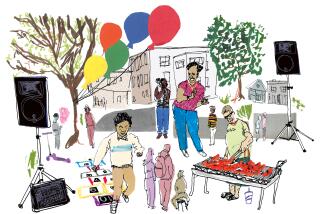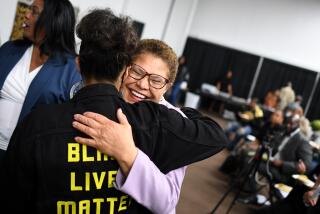Fighting Crime in Your Neighborhood
- Share via
Often, a crime prevention group gets started when the neighborhood faces a specific problem, such as a rash of burglaries or car break-ins, an invasion of drug dealers, a rape, a mugging, or worse--a murder or child abduction. People begin talking about how good it would be to have a safe neighborhood.
Because the subject of crime can be overwhelming, it’s important that you and your neighbors tackle one problem at a time, rather than try to do everything at once. Your efforts will be most effective if you make sure the neighborhood has a solid group of people committed to working together--you only need three or four--before starting any crime prevention projects.
Start With A Planning Committee: The first thing you need is a planning committee--a few people who want to start a neighborhood crime prevention group. It should be kept informal; in fact, you probably won’t even call it a planning committee when you begin. The only requirement for the committee is that members be committed to improving the neighborhood by working together to make it safer.
If you know people in your neighborhood well, it should be easy to pull together a small committee. It could be the couple next door, the woman from down the block who waters your plants when you’re gone or the family with whom you share child care. Look for people you feel you can trust and whose company you enjoy.
In some neighborhoods, people may be more isolated from each other, and you’ll have to build relationships before you start planning a crime prevention group. If you live in a particularly dangerous neighborhood, you may only want to invite the neighbors you know well.
Until your group gets organized, you should not advertise your activities, because street drug dealers or other criminals may threaten neighbors. Better to keep your plans low key in the beginning. But don’t be discouraged. Even in neighborhoods with the most difficult problems, you can find people willing to help.
A small planning committee does not need formal meeting notices and agendas. Most important, the planning committee needs a chairperson--someone to help begin discussions and coordinate the planning process. There should also be a secretary to take notes at meetings and keep track of research information.
It is important for the committee to pick these leaders--even on a short-term basis--otherwise the group can become too loose and unfocused. Most of the time, a chairperson and a secretary will be the only officers a neighborhood group needs. As the group expands or takes on complex projects, it may need other leaders, such as a treasurer if your group holds a fund-raiser or handles money for expenses.
It’s strictly up to you and the members of your planning committee to determine the boundaries of your neighborhood. But as a general rule, you’re better off focusing on a small area in the beginning--for example, two to four residential blocks or your apartment building.
By starting small, neighborhood meetings can be simpler and everyone has a better chance to get to know one another. Most important, your group can build confidence and create a successful track record. If your crime prevention group helps stop one burglar, neighbors will hear about it and become interested in participating.
Research Your Neighborhood’s Crime Problems: If several homes in your area have been burglarized, those incidents will be foremost among your neighbors’ concerns. The planning committee would not have to do a great deal of investigation to uncover this crime issue, but would focus on finding a solution. Perhaps members might talk to police or learn more about Neighborhood Watch techniques and theft prevention and then share information with neighbors.
In many neighborhoods, however, crime seems invisible. Unless neighbors are particularly close-knit, they may not hear about a car break-in or an attempted rape.
Your planning committee will therefore need to get a general consensus of the neighborhood’s major crime worries. You’ll have a good sense of this simply by encouraging people to express their concerns in meetings and by going door-to-door and talking with neighbors. Police can provide additional information about the actual amount and type of crime in the area.
This research will help you identify which crime prevention projects would be the most appropriate for your neighborhood to focus on.
Plan Crime Prevention Projects: A crime prevention project could be a simple meeting to explain how to prevent carjackings, or a project could involve a massive clean-up campaign to get rid of graffiti and combat vandalism.
One tactic is for the planning group to schedule three meetings on the main issues facing the neighborhood. Invite everyone within the boundaries of the neighborhood, including young people over 12. The meeting should be held at a convenient location (usually a home) and time (early weeknight evenings work best).
Schedule Regular Meetings: Neighborhood meetings could be held once a month or perhaps more frequently if enough interest. At the very least, a neighborhood group should have some kind of gathering at least every six months in order to allow neighbors a way to stay in touch. Every meeting should have a clear purpose, such as teaching neighbors how to report suspicious activities to police; planning a block party, or demonstrating street safety techniques. Some meetings might focus more on structural or organizational needs of the group, such as recruiting or setting up a communication system among neighbors.
The main topic could be introduced in a variety of ways: a guest speaker--such as a police officer or an expert on child safety; a film; a presentation by a neighbor or distribution of material on a subject such as graffiti removal.
Mann and Blakeman are the authors of “Safe Homes, Safe Neighborhoods: Stopping Crime Where You Live,” published by Nolo Press, Berkeley, Calif . , from which this article is adapted. “Safe Homes, Safe Neighborhoods” is available in bookstores or by calling (800) 992-6656.


